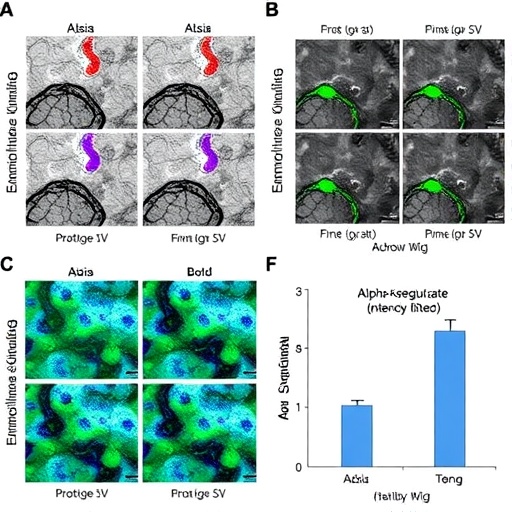In a groundbreaking study published in Nature Communications, researchers have unveiled compelling evidence that alpha-ketoglutarate (α-KG), a pivotal metabolic intermediate, can significantly ameliorate insulin resistance and metabolic inflexibility in a mouse model of Ataxia-Telangiectasia (A-T). This neurodegenerative disorder, notorious for its complexity and severe systemic consequences, has long baffled the scientific community. However, this new research offers a promising avenue for therapeutic intervention by targeting metabolic pathways that were previously underappreciated in the disease’s pathophysiology.
Ataxia-Telangiectasia is a debilitating genetic disorder characterized by progressive neurodegeneration, immunodeficiency, and a predisposition to cancer. Central to its pathology is the defect in the ATM (ataxia-telangiectasia mutated) gene, which encodes a protein kinase essential for DNA damage response and cellular homeostasis. Despite intensive research efforts, treatment options remain largely symptomatic, with no current cure or targeted therapy that modifies the disease course. The metabolic consequences of ATM dysfunction, including insulin resistance and impaired energy utilization, have increasingly come into focus as critical components of disease progression.
The study conducted by Sun, Hart, Herrup, and colleagues explores the hypothesis that metabolic inflexibility—defined as the inability to appropriately switch between fuel sources like fats and carbohydrates—underpins some of the systemic manifestations of A-T. Using an ATM-deficient mouse model that recapitulates many features of the human condition, the researchers administered alpha-ketoglutarate to evaluate its effects on metabolic parameters and insulin signaling pathways. Alpha-ketoglutarate, a key molecule in the tricarboxylic acid (TCA) cycle, has garnered attention for its role in cellular metabolism, redox balance, and epigenetic regulation.
Through meticulous metabolic phenotyping and biochemical assays, the researchers demonstrated that α-KG supplementation effectively restored normal insulin sensitivity in these mice. This outcome was evidenced by improved glucose tolerance tests and enhanced insulin receptor substrate phosphorylation, signifying a rejuvenation of insulin signal transduction. Moreover, the metabolic flexibility of the mice improved markedly, allowing them to better adapt to changes in dietary fuel availability. This reprogramming of metabolic function, the authors suggest, may underlie the systemic benefits of α-KG beyond mere glucose regulation.
At a molecular level, the benefits of α-KG appear to hinge on its multifaceted mechanistic roles. As a TCA cycle intermediate, α-KG is central to energy production and mitochondrial function, both of which are compromised in A-T. The researchers propose that α-KG supplementation replenishes the TCA cycle flux, improving mitochondrial ATP output and reducing oxidative stress—key contributors to the neurodegenerative cascade in A-T. Additionally, α-KG may modulate post-translational modifications and epigenetic marks that influence gene expression patterns critical to maintaining metabolic homeostasis.
Another intriguing finding was the impact of α-KG on lipid metabolism. The treated mice showed normalized plasma lipid profiles and enhanced fatty acid oxidation capacity in skeletal muscle and liver tissues. These changes collectively contributed to the restoration of fuel preference switching between carbohydrates and lipids—a hallmark of metabolic flexibility. The correction of lipid metabolic dysregulation is particularly noteworthy given the frequent observation of dyslipidemia and cardiovascular risk in patients with A-T.
The study also underscores the potential translational impact of targeting metabolic pathways in neurodegenerative diseases. While much of the focus in neurodegeneration has traditionally centered on neuronal survival and inflammation, this research highlights how systemic metabolic dysregulation contributes to disease pathology and how it can be pharmacologically modulated. α-KG, as a naturally occurring, relatively safe metabolic intermediate, could be a candidate for rapid clinical translation, pending further validation studies in humans.
Of significant interest was the study’s integration of advanced metabolomics and proteomics, which allowed for a comprehensive mapping of metabolic networks affected by ATM deficiency and α-KG treatment. This systems biology approach provided nuanced insights into how α-KG reshapes cellular metabolism at multiple levels, revealing potential biomarkers for monitoring disease state and therapeutic response. These molecular signatures may be invaluable in designing personalized treatment regimens for patients afflicted with A-T and possibly other metabolic-linked neurodegenerative disorders.
While the current study focused on a mouse model, the parallels to human physiology are compelling. The authors advocate for the initiation of pilot clinical trials to assess the safety, pharmacokinetics, and efficacy of α-KG supplementation in humans with A-T. Given the limited treatment options and devastating prognosis of the disease, such trials could bring hope for measurable improvements in metabolic health and quality of life for affected individuals.
Importantly, the findings fuel a broader reconsideration of metabolic support as a therapeutic pillar in complex diseases where energy dysregulation plays a central role. The multi-organ benefits observed highlight the interdependence of metabolic networks and the potential for small-molecule metabolic intermediates to enact systemic therapeutic effects. This paradigm may extend beyond A-T to conditions such as diabetes, metabolic syndrome, and other neurodegenerative diseases marked by insulin resistance and mitochondrial impairment.
In conclusion, this landmark research delineates a compelling metabolic axis involving α-KG that addresses the intertwined challenges of insulin resistance and metabolic inflexibility in Ataxia-Telangiectasia. It serves as a testament to the power of metabolic modulation in disease mitigation and paves the way for novel interventions in a field desperate for breakthrough therapies. As the scientific community races to unravel the complexities of neurodegenerative disorders, these findings shine a hopeful light on the metabolic vulnerabilities that can be exploited to alter disease trajectories.
Sun and colleagues have thus provided not only a mechanistic understanding of how α-KG mitigates metabolic disturbances in A-T but also a beacon for future research into metabolic therapeutics. These efforts signal a crucial shift towards harnessing endogenous metabolic molecules for clinical benefit, a strategy that could revolutionize treatments across a spectrum of currently intractable diseases. The promise of α-KG and metabolic reprogramming invites deeper exploration and inspires a new wave of translational research in neurodegenerative and metabolic disorders alike.
Subject of Research: Ataxia-Telangiectasia, insulin resistance, metabolic inflexibility, alpha-ketoglutarate, mouse model.
Article Title: Alpha-ketoglutarate mitigates insulin resistance and metabolic inflexibility in a mouse model of Ataxia-Telangiectasia.
Article References:
Sun, J.KL., Hart, R.P., Herrup, K. et al. Alpha-ketoglutarate mitigates insulin resistance and metabolic inflexibility in a mouse model of Ataxia-Telangiectasia. Nat Commun 16, 9312 (2025). https://doi.org/10.1038/s41467-025-64360-8
Image Credits: AI Generated




